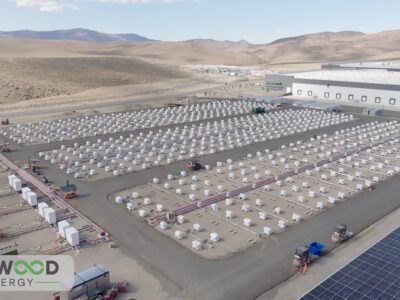(Bloomberg) —
Hedge funds are betting against oil stocks and winding back shorts on solar in a reversal of positions that dominated their energy strategies over the past four years.
Since the beginning of October and through the second quarter, equity-focused hedge funds have — on average — been mostly short oil stocks, according to a Bloomberg Green analysis of positions on companies in global indexes for sectors spanning oil, wind, solar and electric vehicles. That’s a reversal of bets that had dominated since 2021, according to the data, which are based on fund disclosures to Hazeltree, an alternative-investment data specialist.
Over the same period, funds have unwound short bets against solar stocks. The analysis, which is based on a universe of some 700 hedge funds representing about $700 billion in gross assets also shows that portfolio managers have stayed net long wind in the period.
There has been “a bottoming out with some of these clean energy plays,” said Todd Warren, portfolio manager at Tribeca Investment Partners Pty. That trend has “really occurred at the same time as we’ve seen — in the oil patch — some concerns with regards to supply and demand balance,” he said.
The analysis shows that more hedge funds were, on average, net short stocks in the S&P Global Oil Index than net long for seven of the nine months starting October 2024. By contrast, net longs exceeded net shorts in all but eight of the 45 months from January 2021 through September 2024.
The development coincides with a rise in oil supply as some OPEC+ member nations act to preserve their market share. Joe Mares, a portfolio manager at Trium Capital, a hedge fund managing about $3.5 billion, notes that ratcheting up output has “not historically been great” for the oil industry. Evidence of an economic slowdown in the US and China, combined with an expectation that global oil inventories will continue to rise through the rest of 2025, means there’s growing skepticism toward the sector.
Once investors take in “the general slowdown in everything,” the question then becomes, “who’s buying the oil?” said Kerry Goh, Singapore-based chief investment officer at Kamet Capital Partners Pte.
Greenwich, Connecticut-based Tall Trees Capital Management LP is short oil stocks because “we see much lower oil prices, especially in 2026,” said Lisa Audet, the fund’s founder and chief investment officer.
Investors may get further insight into the supply-demand balance as early as this week, with OPEC set to release its monthly market analysis. Updates are also due from the US Energy Information Administration and the International Energy Agency. On Monday, oil held close to two-month lows.
In the US, meanwhile, President Donald Trump’s quest to add supply in an effort to bring down the price of oil has unsettled local producers.
The Dallas Fed’s latest quarterly energy survey, published on July 2, shows negative sentiment among oil companies toward the Trump administration’s policy on the fossil fuel. One respondent in the anonymized study said the administration’s implied price target of $50 a barrel is simply unsustainable for the industry. Another spoke of the “chaos” caused by current US trade policies, adding the volatility will drive companies to “lay down rigs.”
Meanwhile, the outlook for solar and wind stocks is starting to improve.
The analysis of Hazeltree’s data shows that the average share of funds that were net short stocks in the Invesco Solar ETF dropped to 3% in June. That’s the lowest percentage since April 2021, when green equities were trading near record highs. The number of funds net long stocks in the First Trust Global Wind Energy ETF reached a 30-month high in February this year. Those positions fell back in June, but net longs still dominated shorts overall.
Other hedge fund managers said AI has the potential to trigger a generational swell in energy demand that is likely to give new support to renewables.
“The market is telling you that AI is the biggest thing we’ve seen in our entire careers,” said Karim Moussalem, chief investment officer of equities at London-based Selwood Asset Management LLP, which manages about $1.6 billion. To meet energy demand from AI, renewables will need to play a big part, not least “because they’re the fastest to market,” he said. Renewables are likely to meet more than half of the required additional generation capacity by 2035, BloombergNEF said in a report last month.
In China, green stocks are now enjoying a rebound after its solar industry started addressing overcapacity concerns. After losing about half its value between the end of 2021 and 2023, the Solactive Select China Green Energy Index — which includes solar giant Longi Green Energy Technology Co. — has advanced around 19% from an April low.
In the US, Trump administration attacks on green energy — including a rollback of Biden-era subsidies — have already contributed to over $22 billion of clean energy projects being canceled or delayed since January, according to an analysis from the E2 advocacy group.
Yet, for a number of fund managers, the decision to slash green subsidies helps end some of the policy uncertainty that had prevented investors from moving into wind and solar.
“At least now we know what the rules are going to be and so people can go back to evaluating these as businesses,” Mares said.
The final version of Trump’s $3.4 trillion budget bill — dubbed the One Big Beautiful Bill — was actually more favorable toward some corners of the renewables market than Tall Trees Capital’s Audet expected. Utility-scale solar, for example, has emerged as a relative winner, she said.
For green investors, it’s been “less bad than expected,” said Nishant Gupta, founder and chief investment officer of Kanou Capital LLP, an energy transition-focused hedge fund. “There’s been more protection around US domestic production than expected.”
And this year’s tariff wars have coincided with a broad rebound in green stocks. Since Trump first unveiled his proposed tariffs on April 2 — dubbed Liberation Day by the White House — the main S&P index tracking clean energy stocks has added about 18%. Over the same period, the main S&P index for oil companies is down around 4%.
Much of the clean-energy rebound has been driven by solar. The Invesco Solar ETF, a widely tracked exchange-traded fund packed with solar stocks, is up more than 18% since April 2.
More hedge funds continue to be short stocks in the Kraneshares Electric Vehicles and Future Mobility Index ETF than long — a constant since 2021 as China has steadily displaced Western manufacturers. But the share of net shorts dropped to 2.87% in June, which is the second-lowest level in almost half a decade.
At the same time, there’s an expectation among fund managers that the continued rise in sales of EVs globally will reduce the need for petroleum. That matches BloombergNEF estimates, which anticipate a 25% annual increase in EV sales this year. BNEF also expects that about 40% of vehicles on the road could be electric by 2040, displacing 19 million barrels of oil a day by that year.
The strategy shift among funds reflects the fact that economic growth without low-carbon energy is now inconceivable, according to Trium’s Mares.
“If we are going to continue to grow both in developed and emerging economies, we’re going to need a lot of energy,” he said. “A big chunk of the marginal growth in energy over the last 10 years has come from renewables and it’s hard to see why that isn’t going to continue.”
Methodology
Bloomberg Green analyzed anonymized weekly data that around 700 hedge funds disclosed to Hazeltree, from January 2021 through 27 June 2025. The hedge funds in the Hazeltree database vary in terms of assets under management, and the analysis is not weighted by hedge fund assets or size of position held. Collectively, gross AUM for the hedge funds analyzed is around $700 billion. Total assets under management in the hedge fund industry were around $4.7 trillion, net, at the end of the second quarter 2025, according to Hedge Fund Research. Bloomberg also interviewed hedge fund managers on their oil and energy transition bets and on trends from the data analysis.
Hedge funds mostly provided their data to Hazeltree via prime brokers. There is a possibility that some positions may not be disclosed. These will not be included in Hazeltree’s data or in the Bloomberg analysis.
Hazeltree’s data reports percentages of the hedge funds that held net long positions and net short positions for a specific stock. Bloomberg’s analysis categorized roughly 230 stocks based on key ETFs or indices for a sector, and further calculated a sector-wide monthly average. In some cases, the same company could be included in different sectors. Four stocks didn’t appear in the Hazeltree data provided to Bloomberg.
ETFs and indices used in the analysis are S&P Global Oil Index, Invesco Solar ETF, First Trust Global Wind Energy ETF and KraneShares Electric Vehicles & Future Mobility Index ETF.
(Adds reference to oil price in ninth paragraph. An earlier version corrected the third paragraph to clarify that $700 billion for 700 funds reflects gross aum; and made the same clarification in the Methodology section.)
To contact the authors of this story:
Natasha White in London at nwhite107@bloomberg.net
Demetrios Pogkas in New York at dpogkas@bloomberg.net
Liza Tetley in London at ltetley@bloomberg.net
Ishika Mookerjee in Singapore at imookerjee@bloomberg.net
© 2025 Bloomberg L.P.





